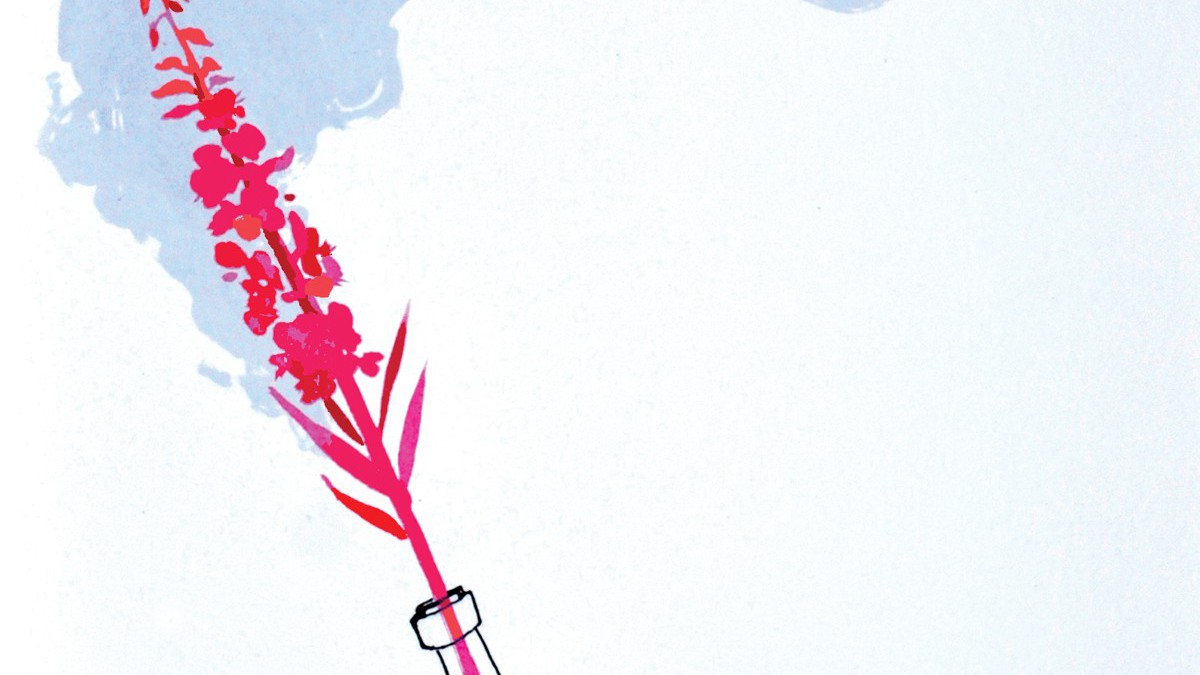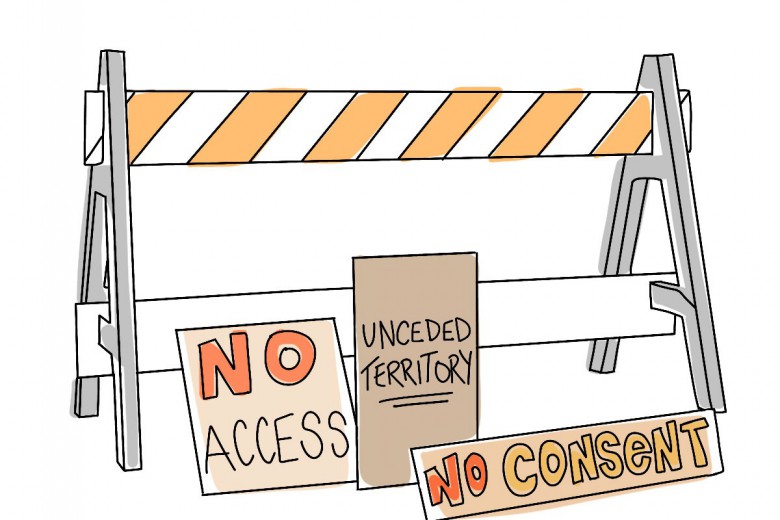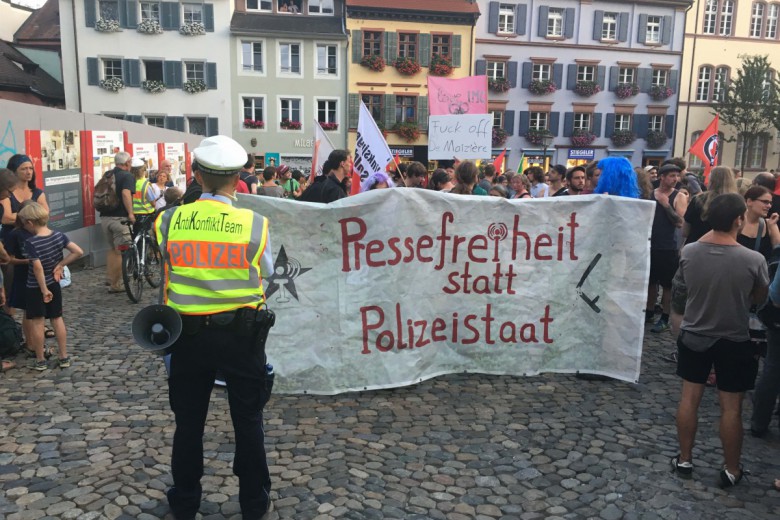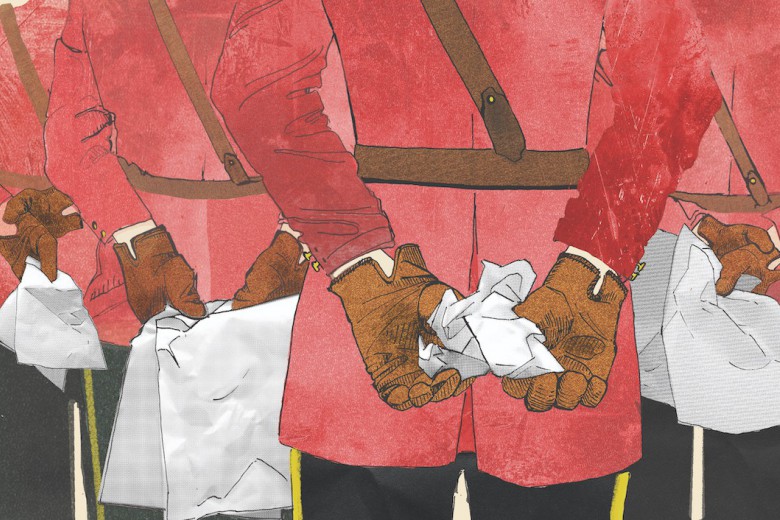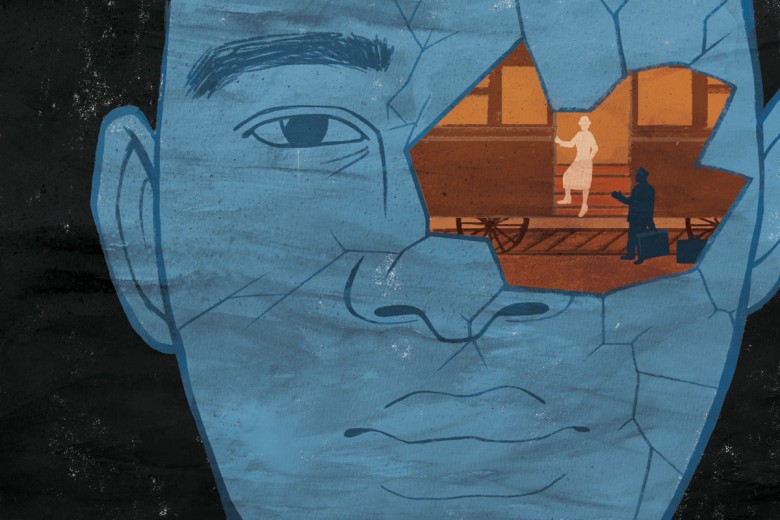On August 12, 2017, 32-year-old Heather Heyer was marching with a group of protesters at an antifascist counter-rally in Charlottesville, Virginia, when a white nationalist crashed his car into the crowd, killing Heyer and injuring 19 others. The night before, fascist organizers marched through the University of Virginia with torches shouting, “White lives matter,” and the Nazi slogan, “Blood and soil.”
The next day, I joined hundreds of others at a solidarity rally in Montreal, one of many held across the U.S. and Canada. We came together to share our outrage and to support each other through direct action.
From anti-Nazi organizing in the 1930s to the radical no-platform work of Anti-Racist Action in the 1990s and 2000s, today’s antifascist activists draw upon decades of experience fighting the far right.
Meanwhile, mainstream commentators worked hard to discredit the legitimacy of these and other actions organized by antifascists. In the wake of recent debates about antifascist organizing and calls to dismantle statues of John A. Macdonald, the National Post published opinion pieces by CBC commentator Rex Murphy and former newspaper magnate Conrad Black. Black denied Canada’s history of slavery and colonization, and insisted that the country is devoid of the white nationalist fervour currently filling U.S. headlines, while Murphy derided anti-racist activists as unreasonable “antifa” thugs who are just as violent as the fascists they claim to be fighting. These reactionary sentiments obscured the politics, aims, and history of antifascism in Canada. From anti-Nazi organizing in the 1930s to the radical no-platform work of Anti-Racist Action (ARA) chapters throughout the 1990s and 2000s, today’s antifascist activists draw upon decades of experience fighting the far right and use a wide range of tactics and strategies. Far from being a violent organization, autonomous antifascist organizers fight against racist, homophobic, and xenophobic attacks on those most marginalized by an already-broken system.
Settler nativism and Canada’s far right
Fascism’s ideological emphasis on nationalism, racial hierarchy, and patriarchal order has had a sustained presence among Canada’s far right since its emergence in the 1920s. Although white nationalist movements are often written off as fringe tendencies of an otherwise tolerant society, they are an extension of structural inequalities already enacted by the settler-colonial nation-state: strict immigration policies against non-whites, the dispossession and assimilation of Indigenous peoples, and the promotion of Canadian nationalism.
Under the pretext of free speech, far-right movements typically capitalize on people’s exploitation under capitalism to stir up a form of social unrest that scapegoats those already marginalized. In the 1920s, Klansmen blamed social disorder and unemployment on Japanese, Chinese, and South Asian immigrants in B.C., and in Saskatchewan claimed that Jewish and Black immigrants “put white Canadians … out of business.” During the Great Depression, Canada’s self-proclaimed führer, Adrien Arcand, published racist newspapers in Quebec and managed to fill Massey Hall with 1,500 fascist supporters who revelled in his anti-Semitic conspiracy theories and staunch nationalism. And during periods of economic recession in the mid-1980s and early 1990s, white power movements increasingly attracted disaffected young people by offering racist explanations for white working-class poverty.
Under the pretext of free speech, far-right movements typically capitalize on people’s exploitation under capitalism to stir up a form of social unrest that scapegoats those already marginalized.
Steeped in a politics of fear and hatred, far-right ideologues mobilize anti-establishment sentiments through a reactionary nationalist politics, rather than critical working-class or anti-racist consciousness. Far-right groups adopt the coded language of “white nationalism” as an attempt to legitimize their desires and distance themselves from Nazism or white supremacy, but the underlying genocidal and racist politics remain. In these movements, allegiances to pure ideas of “law and order” prevail as leaders call for the restoration of a “once-great nation.” The movements are incubated within capitalist democracies and often protected by the police. During the 1930s, police in Montreal and Toronto focused more on shutting down communist and socialist groups than on the activities of fascist organizations. Chief Draper’s anti-communist “Red Squad” in Toronto, for instance, prevented left-wing rallies while doing little to stop swastika clubs from inflicting violence on the Jewish working-class community. In 1993, during a Toronto ARA protest, mounted police charged into a crowd of about 500 protesters to escort neo-Nazis into a courthouse. In later news reports, police tried to distance themselves from the Nazis and some media commentators described anti-racist organizers as terrorists.
Reactionary white supremacist movements in Canada have consistently been challenged by antifascists who organize against their violent politics. In the 1930s, working-class Jewish communities and their allies fought Nazis off the streets of Toronto and Winnipeg. Later that decade, Canadian communists and anarchists fought in the Spanish Civil War against Franco’s fascism. In the 1960s, anti-racist groups like N3 – named after Newton’s third law (for every action, there is an equal and opposite reaction) – outnumbered and shut down public neo-Nazi rallies in Toronto. And when neo-Nazi hate groups gained traction again in the 1980s and 1990s, ARA chapters ran them out of town.
Anti-Racist Action takes out the trash
In September 1992, word got around that the Heritage Front – a neo-Nazi hate group formed in 1989 – would be protesting a hearing of the Ontario Human Rights Commission in Toronto regarding a complaint filed by Rodney Bobiwash, founder of Klanbusters and executive director of the Native Canadian Centre, against the Heritage Front’s hotline, which promoted anti-Indigenous hatred and racism. But when the Heritage Front marched to the courthouse, a crowd of self-described “rowdy punks and street youth” broke them up and exchanged blows to send a clear message: zero tolerance for hate. While the neo-Nazis regrouped and entered the courthouse through another entrance, outside the antifascists exchanged names and numbers to start organizing: something had to be done to shut down the Heritage Front for good. There, out on the streets, Toronto’s chapter of Anti-Racist Action was born.
The Toronto organizers were inspired by ARA chapters in the U.S. ARA emerged out of Minneapolis’ punk subculture in the late 1980s. Influenced by anarchist politics, ARA and similar groups aimed to reaffirm the working-class and anti-racist political origins of punk subcultures.
“The idea was to interfere with and prevent fascists from organizing,” Lola, a veteran of ARA Toronto, tells me. “It was a very practical goal, with concrete victories: When we started, there were racist rock concerts happening in downtown Toronto, a racist hotline, and stores selling white power merchandise, but by the time we stopped organizing in the mid-2000s, we had shut them all down and white supremacists could no longer organize in the city.”
Four points of unity were adopted by the Midwest Anti-Fascist Network (which became the ARA Network a year later) at its conference in Columbus, Ohio, in 1994:1. We go where they go. Whenever fascists are organizing in public, we’re there. We don’t believe in ignoring them or staying away from them. Never let the Nazis have the streets.
2. We don’t rely on the cops and the courts to do our work. That doesn’t mean we never go to court. But we must rely on ourselves to protect ourselves and to stop the fascists.
3. Non-sectarian defense of other anti-fascists. In the ARA Network we have lots of different groups and individuals. We don’t agree about everything and we have a right to differ openly. But in this movement an attack on one is an attack on us all. We stand behind each other.
4. ARA intends to do the hard work necessary to build a broad, strong movement against racism, sexism, anti-Semitism, homophobia, discrimination against the disabled, the oldest, the youngest and the most oppressed people. We support abortion rights and reproductive freedom for all. We want a classless society. We intend to win!
ARA Toronto used a variety of tactics to achieve these goals, including street patrols of white nationalist hangouts and monitoring of their organizing, campaigns to expose white supremacists to their neighbours, and public protests at fascist gatherings and events. These strategies were drawn from other ARA chapters and were rooted in Toronto’s existing organizing through the Riverdale and Parkdale Action Committees Against Racism, Klanbusters, and the Black Action Defense Committee, which protested police violence. Later, ARA would confront anti-Native organizing in the aftermath of Dudley George’s murder by the Ontario Provincial Police in 1995 at the Ipperwash land reclamation.
Antifascists are often critiqued for their use of direct action to shut down the far right, but describing antifascist tactics as expressly violent is misleading. Far-right and neo-Nazi politics are inherently violent because they aim to normalize hate speech, racism, and homophobic attacks that directly threaten marginalized communities. Antifascists, in contrast, organize to stop this hate and to shut down any platform that is used to reproduce oppression. So, while antifascists have at times engaged the far-right violently, these actions are a form of proactive self-defence. Violence is not the end intention of these tactics, but a regrettable necessity in the fight for a better, more just society.
Mike Barber joined the Toronto chapter of the ARA in 1995 after seeing the group table at hard-core concerts and reading about them in zines.
“A big initiative we had was organizing the first Youth Against Hate conference in 1996,” Barber tells me. “People came from all over the U.S. and Canada, and we tried to pull in and politicize young organizers through talks and workshops…. At the time, I was also tabling at concerts and trying to start up satellite groups in high schools.” The ARA also held their own rock- and rap-against-racism fundraisers and worked to politicize young people.
“There is a hunger for information and ideas among young people,” explains Lola. “They know things are screwed up and they want to do something about it.” Far from being an exclusively confrontational or reactive group, ARA aimed to develop anti-racist, feminist, and anti-colonial politics in local youth cultures through actively engaging youth in popular hangout spots, and by producing their own zines and news bulletins.
After a few years of successful confrontation, ARA had shut down the Heritage Front, and several of the Heritage Front’s members, including its leader, Wolfgang Droege, had been criminally charged. With their leaders exposed and their rallies confronted, far-right and white supremacist organizers fled Toronto for the suburbs and other cities. But ARA, in coalition with other anti-racist groups, continued to organize against the few vocal fascists who remained.
Building everyday antifascism
While the landscape of far-right organizing has changed since the 1990s, Barber, a founding member of Toronto Against Fascism, tells me that new far-right groups, splinters, and formations seem to pop up frequently, though not all of them organize around overtly fascist politics: Soldiers of Odin (SOO), III%ers, Storm Alliance, Proud Boys, the Worldwide Coalition Against Islam, the Canadian Coalition of Concerned Citizens (CCCC), Rise Canada, La Meute, Patriotic Europeans Against the Islamisation of the West (Occident) (Pegida), the Nationalist Party of Canada, and others. But these new formations differ from the overtly bigoted neo-Nazi organizing of the 1990s.
“They’re proto-fascist,” explains Jason Devine, who has been an antifascist organizer since the early 2000s. “Groups like SOO have a democratic veneer, do populist ‘acts of community service,’ and don’t actively call themselves fascists, but if you dig deeper, you find the same politics of genocide and white power.” A recent alt-right “anti-Trudeau” rally planned in Toronto, for instance, tried to brand itself as a mainstream right-wing event but was organized by a swastika-tattooed member of the neo-Nazi Canadian Nationalist Front. Once they heard about the counter-rally and the planned police presence, the fascists cancelled their rally, but flyers were found in the adjacent park wishing people a “happy European heritage week,” and proclaiming that “racism is as natural as breathing.”
Still other groups expound a loose politics of Islamophobia and anti-refugee sentiment, but the potential for violence remains. When the Soldiers of Odin arrived at a rally in Nathan Phillips Square on October 21, they wore helmets and combat boots, and pushed antifascist demonstrators on their way to join a group of racist protesters behind police lines. In Hamilton, Barber recalls seeing III%ers wearing tactical vests and reinforced gloves, and at a rally at Calgary city hall, Devine says III%ers had stun canes and bragged on social media about carrying knives. Antifascist organizers are acutely aware of the potential of violence.
Omar Kinnarath, a founding member of Winnipeg’s Fascist Free Treaty 1 (FF1), a group that has successfully shut down CCCC rallies, explains, “One thing we’ve learned from the older generation is to take a broad-based community approach to antifascist organizing. We do a lot of intelligence gathering [on the far-right], and some folks do bloc up at rallies, but we also reach out to the younger generation at high schools and all-ages shows, we liaise with the media, with community groups, and different leftist organizations.”
When I ask these organizers what others on the left can learn from antifascist politics, they all speak of the importance of building a non-sectarian mass movement. Historically, fascism has taken hold when leftist movements were internally divided. Antifascists today emphasize the need for a diversity of tactics while engaging in violence as a last resort. In some ways, antifascism is a reactive politics that ebbs and flows as the far right gains or loses traction. But it is also clear that many antifascists are connected to broader, long-term revolutionary politics and other organizing grounded in feminist, anti-racist, and anti-capitalist politics. Strengthening support and developing broad-based coalitions between antifascists and existing movements for environmental, queer, working-class, and racial justice is an essential feature of leftist organizing.
When I ask these organizers what others on the left can learn from antifascist politics, they all speak of the importance of building a non-sectarian mass movement.
Normalizing antifascism as an everyday politics and developing a mass antifascist movement is key to shutting down hate for good, and those activists who do put their bodies on the line to confront racists should be supported. As Devine says, “not everyone can, or wants to, expose themselves to far-right violence, but there’s something for everyone in this movement – from educational work, to financial help, to just showing up and supporting those [who] do put their bodies on the line.”
For antifascist organizers, there’s no question that there is a pressing need to shut down far-right organizers, not only because of their immediate harm, but because they aim to normalize hate in an attempt to widen their base. And while antifascists are asking for broad-based support from the left, another lesson to be gleaned from ARA’s history is to be at peace with not pleasing everybody. As Lola explains, “They’ll still be happy later when there are no Nazi boneheads walking around on the streets.”
To support antifascist organizing, consider donating to the International Anti-Fascist Defence Fund: intlantifadefence.wordpress.com.


